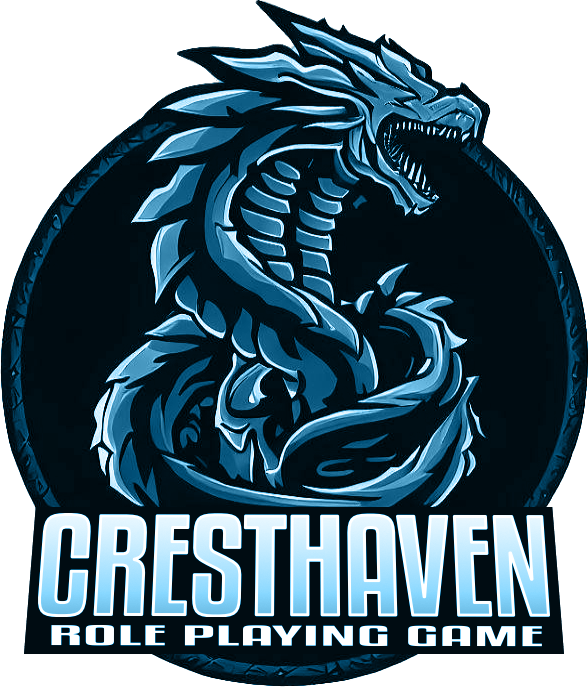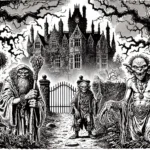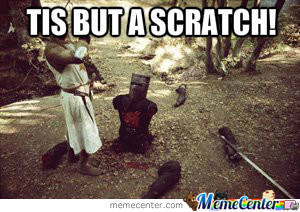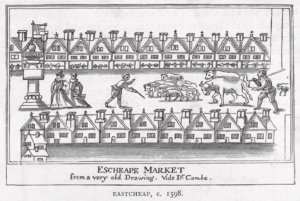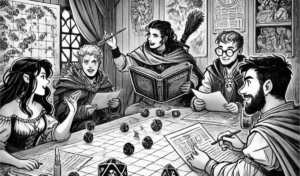TABLE OF CONTENTS
I. UNDERSTANDING DISEASE IN YOUR GAME
- Why Use Diseases?
- When NOT to Use Diseases
- Disease as Drama vs. Disease as Punishment
II. CORE MECHANICS
- Contraction & Exposure
- Occurrence Types
- Severity Levels
- Ability Score Drain
- Recovery & Treatment
III. MASTER DISEASE TABLES
- Random Disease Determination
- Contraction Chance Tables
- Environmental Modifiers
- Carrier Exposure Rules
IV. COMPLETE DISEASE COMPENDIUM
- Mundane Afflictions
- Magical Maladies
- Exotic Afflictions
- Parasitic Infestations
- Beneficial Diseases
V. RUNNING DISEASES AT THE TABLE
- Tracking Disease Progression
- Player Agency & Cure Quests
- Balancing Lethality
- Disease-Based Adventures
VI. DISEASE CREATION TOOLKIT
- Building Your Own Diseases
- Themed Disease Tables
- Regional Disease Lists
I. UNDERSTANDING DISEASE IN YOUR GAME
Why Use Diseases?
Diseases serve multiple purposes in OSR gaming:
VERISIMILITUDE: Adventurers who wade through sewers, sleep in dungeons, and fight rats should occasionally get sick. Disease grounds fantasy in consequence.
RESOURCE DRAIN: A party that can trivially heal combat damage faces new challenges when remove disease spells become precious resources.
ADVENTURE HOOKS: “The princess is dying of Moonblind – only tears from the Moon Goddess can save her” creates instant motivation.
ENVIRONMENTAL STORYTELLING: Different regions feel distinct when swamps carry Gloom Spores while mountain tombs inflict Fossil Creep.
TACTICAL DEPTH: Players must weigh risks. Do we explore that mummy’s tomb? Can our cleric spare the spell slot?
CHARACTER MOMENTS: How does the noble paladin react when afflicted with disfiguring leprosy? What happens when the wizard loses INT to Word Rot?
When NOT to Use Diseases
AVOID DISEASES IF:
- Your players find bookkeeping unfun – disease tracking requires record-keeping
- Your campaign is heroic power fantasy – diseases undermine power levels
- You lack time for cure quests – diseases deserve resolution, not forgotten character sheets
- Your table lacks trust – disease can feel like DM fiat punishment
- Your game is already gritty enough – don’t pile misery on misery
SKIP DISEASE CHECKS WHEN:
- The party just suffered major losses
- Disease would derail important plot moments (use sparingly – consequences matter!)
- It’s been less than 3 game-months since last disease incident
- The affliction would be boring rather than dramatic
Disease as Drama vs. Disease as Punishment
GOOD USE – DRAMA: “You contracted Serpent’s Kiss from the yuan-ti priest’s dying curse. Your blood runs cold. The expedition into the frozen north just got complicated – but the Fire Lily growing there might cure you…”
BAD USE – PUNISHMENT: “You failed your save. You have Gutter Grit. You lose 1 STR and 1 CON per week until you get remove disease cast. Next?”
THE DIFFERENCE:
- Drama creates story opportunities
- Drama involves player choice and agency
- Drama has interesting consequences beyond numbers
- Drama offers multiple solutions (magical, mundane, exotic)
- Punishment just removes numbers from the sheet
- Punishment offers no choices
- Punishment makes players feel helpless
GOLDEN RULE: Every disease should create at least one interesting decision or story opportunity. If it doesn’t, skip it.
II. CORE MECHANICS
Contraction & Exposure
When to Check for Disease
MONTHLY CHECKS (Routine): Roll once per game month during normal adventuring. This represents accumulated exposure to normal hazards.
WEEKLY CHECKS (Hazardous Conditions):
- Very hot weather or hot, moist weather
- Filthy, crowded conditions in warm weather
- Swamp, jungle, or marsh exploration
- Siege conditions or refugee camps
- Extended dungeon delving (4+ weeks underground)
IMMEDIATE CHECKS (Direct Exposure):
- Bitten by diseased creature
- Drinking contaminated water
- Eating spoiled or cursed food
- Attacked by disease-carrying monster (mummy, rot grub, etc.)
- Exposure to disease trap or environmental hazard
- Sharing enclosed space with infected person for 1+ days
- Triggering specific disease curse
Base Contraction Chances
STANDARD DISEASES: Base Chance: 2%
Modifiers:
- Currently diseased or parasitically infested: +1%
- Crowding (city, encampment, shipboard): +1%
- Filth (garbage, sewage, poor sanitation): +1%
- Character is old (age 50+): +2%
- Marsh, swamp, or jungle environment: +2%
- Hot and moist climate: +2%
- Character is venerable (age 70+): +5%
- Exposure to carrier of communicable disease: +10%
- Cool weather or climate: -1%
- Cold weather, high mountains: -2%
- Shipboard after 2+ weeks at sea: -2%
PARASITIC INFESTATIONS: Base Chance: 3%
Modifiers:
- Filth (garbage, manure, sewage): +1%
- Improperly cooked meat: +2%
- Polluted water: +5%
- Swamp or jungle environment: +5%
- Cool weather, desert climate: -1%
- Cold weather, high mountains: -1%
MAGICAL DISEASES: These typically don’t use percentage chances. Instead:
- Monster attack: Save vs. Poison/Death or contract disease
- Cursed item: Automatic contraction, Save determines severity
- Trap: Save as trap level indicates
- Environmental: Exposure time determines automatic contraction
Constitution Modifiers to Disease Rolls
Apply AFTER determining base chance, when rolling for specific character:
| Constitution | Occurrence Modifier | Severity Modifier |
|---|---|---|
| -2 and Under | +2 | +2 |
| -1 | +1 | +1 |
| 0 | 0 | 0 |
| +1 | -1 | 0 |
| +2 | -1 | -1 |
| +3 | -2 | -1 |
| +4 | -2 | -2 |
Additional Modifiers:
- Has chronic disease/disorder: +1 to both
- Severe parasitic infestation: +1 to both
- Under 25% of normal HP: +1 to both
- Roll of 0 or less = no disease contracted
Occurrence Types
ACUTE (Single Attack)
Disease runs its course once and is done. Character either recovers or dies. Most common type.
Examples: Gutter Grit, Bog Lung, Dungeon Fever
Determination: Roll 1d6 when disease contracted:
- 1-3: Chronic
- 4-6: Acute
(Some diseases are always one or the other – noted in description)
CHRONIC (Recurring)
Disease becomes part of character’s system, recurring periodically. Each recurrence follows normal severity progression.
Recurrence Schedule:
- Roll 1d6 months for first recurrence
- Roll 1d4 months for subsequent recurrences
- Stress, injury, or environmental triggers may cause immediate recurrence (DM discretion)
CRITICAL RULE: If two chronic diseases occur simultaneously, BOTH increase one severity level. Chronic Mild + Chronic Mild = both become Severe. This makes chronic diseases genuinely threatening.
Examples: Lycanthropy (always chronic), Spell Bug, Purple-Eye Fever
Severity Levels
Roll for severity when disease is contracted (after determining occurrence):
Standard Roll: 1d6
- 1-2: Mild
- 3-4: Severe
- 5-6: Terminal
For deadlier diseases: 1d8
- 1-2: Mild
- 3-5: Severe
- 6-8: Terminal
MILD SEVERITY
Effects:
- Cannot perform strenuous activity (no adventuring)
- Must rest in safe location
- Apply disease-specific ability score drain (if any)
- Apply any special effects listed in disease description
Duration: 1d3 weeks (roll 1d6: 1-2 = 1 week, 3-4 = 2 weeks, 5-6 = 3 weeks)
Treatment:
- Bed rest and appropriate treatment reduces duration by half
- Remove disease or similar magic cures immediately
- Disease-specific cures work as described
Ability Loss: Temporary unless disease specifies otherwise. Recovers at 1 point per week after cure.
SEVERE SEVERITY
Effects:
- Character reduced to 50% of maximum hit points
- Totally disabled for 1d2 weeks
- After disabled period, disease moves to Mild state for additional 1d2 weeks
- Apply disease-specific ability score drain
- Apply any special effects (usually worse than Mild)
Duration: 1d2 weeks disabled + 1d2 weeks mild = 2-4 weeks total
Treatment:
- Bed rest and treatment required for survival
- Without proper care, 25% chance disease worsens to Terminal
- Magical healing restores HP but doesn’t cure disease
- Remove disease cures immediately but HP must still be healed
- Lost ability points return at 1 per week after cure
Ability Loss: Often permanent for severe attacks (check individual disease). If temporary, recovers at 1 point per 2 weeks.
TERMINAL SEVERITY
Effects:
- Death (or permanent disability) in specified timeframe
- Character completely incapacitated
- Apply rapid ability score drain
- No natural recovery possible
Death Timeframes by System Affected:
- Brain: 1d12 hours
- Cardiovascular: 1d12 days
- Blood/Bone: 1d12 weeks
- Gastro-intestinal: 1d12 weeks
- Respiratory: 1d12 months
- Muscle: 1d12 months
- Generative organs: 1d12 months
- Skin: 1d12 weeks
- Eyes/Ears: Not death, but permanent blindness/deafness
- Special diseases: As listed in description
Treatment:
- Remove disease cast before death/transformation prevents it
- Heal or restoration may cure (DM discretion based on disease)
- Disease-specific cures (quest items, rare rituals)
- Some terminal diseases cannot be cured, only delayed
Ability Loss: Always permanent. Character dies or transforms when key ability reaches 0.
Ability Score Drain
Different diseases attack different body systems. This determines which ability scores drain and at what rate.
Drain Rates by Severity
MILD:
- Specified ability scores: -1 per week
- No permanent loss unless disease specifies
SEVERE:
- Specified ability scores: -1 per week
- Often permanent loss (see specific disease)
- Chronic severe attacks accumulate permanently
TERMINAL:
- Rapid drain as specified per disease
- Always permanent
- Death/transformation at 0 in key ability
System-Specific Ability Loss
BLOOD/BONE AFFLICTIONS:
- Lose 1 STR and 1 CON per week
- Chronic cases accumulate slowly
- Terminal: 1d12 weeks until death
BRAIN/NEUROLOGICAL:
- Lose 1 INT and 1 DEX per occurrence
- Chronic cases eventually fatal
- Terminal: 1d12 hours until death
CARDIOVASCULAR-RENAL:
- Lose 1 STR and 1 CON per week
- Same as blood afflictions
- Terminal: 1d12 days until death
CONNECTIVE TISSUE (Leprosy-type):
- Lose 1 point each: STR, DEX, CON, CHA per month
- Only severe cases cause loss
- Terminal: Until CON reaches 0 (treat as chronic severe)
GASTRO-INTESTINAL:
- Lose 1 STR and 1 CON per occurrence
- Severe attacks = permanent loss
- Terminal: 1d12 weeks until death
JOINT DISORDERS:
- Lose 1 DEX per occurrence
- Severe attacks = permanent loss
MUCOUS MEMBRANE:
- Lose 1 CON per occurrence
- Severe attacks = permanent loss
MUSCLE DISORDERS:
- Lose 1 STR and 1 DEX per occurrence
- Severe attacks: 25% chance of permanent loss
- Terminal: 1d12 months until death
NOSE-THROAT:
- Chronic severe: 10% chance of 1 CON loss per attack
RESPIRATORY:
- Chronic severe: 10% chance each of 1 STR and 1 CON loss (roll separately)
- Terminal: 1d12 months until death
SKIN AFFLICTIONS:
- Severe: 10% chance of permanent 1 CHA loss
- Chronic mild: 10% chance per occurrence
- Chronic severe: 25% chance per occurrence
- Terminal: 1d12 weeks until death
URINARY SYSTEM:
- Chronic severe: 20% chance of 1 DEX and 1 CON loss per occurrence
- Terminal: 1d12 weeks until death
Death and Transformation
CHARACTER DIES WHEN:
- Terminal disease reaches end of timeframe
- Any ability score reduced to -5 (unless disease specifies transformation)
- Combination of multiple diseases reduces HP below negative CON
CHARACTER TRANSFORMS WHEN:
- Mummy Rot: Becomes mummy at STR -5
- Lycanthropy: Permanent beast form if not treated in time
- Clockwork Consumption: Becomes automaton at CON -5
- Spell Bug: Becomes mindless vessel at WIL -5
- Other transformation diseases: As specified
Recovery & Treatment
Natural Recovery
MILD DISEASES:
- 1d3 weeks bed rest in clean, safe environment
- Proper food and water required
- Appropriate treatment (herbs, poultices, clean bandages) reduces time by half
SEVERE DISEASES:
- 1d2 weeks total disability (bed-bound)
- Additional 1d2 weeks mild state
- Requires attendant/healer or 25% chance of worsening to terminal
- Proper treatment required to prevent death
TERMINAL DISEASES:
- No natural recovery
- Only delays death without magical intervention
Magical Healing
CURE LIGHT/MODERATE WOUNDS:
- Restores HP but does NOT cure disease
- May temporarily improve symptoms (DM discretion)
REMOVE DISEASE (2nd/3rd level):
- Immediately cures most diseases
- Lost ability points return at 1 per week (1 per 2 weeks if severe)
- Does NOT cure: Advanced terminal diseases, transformations in progress, some magical curses
- Does NOT restore HP – must be healed separately
HEAL (6th level):
- Cures any disease and restores all HP
- Returns ability points at double normal rate
- Stops even terminal diseases
RESTORATION:
- Required for permanent ability loss from severe/terminal diseases
- Returns 1 ability point per casting
- Expensive component cost
WISH:
- Cures anything
- Instantly restores all ability loss
- Only reliable cure for some exotic diseases
Mundane Treatments
HERBAL REMEDIES:
- Reduce duration by 25-50%
- Provide +1 to +2 on saves against worsening
- Require successful herbalism/healing check
- May be disease-specific (Fire Lily for Serpent’s Kiss)
PROPER CARE:
- Clean environment prevents worsening
- Attendant reduces chance of severe→terminal progression
- Appropriate diet aids recovery
SURGICAL INTERVENTION:
- May remove parasites
- Can amputate infected limbs (prevents spread)
- Risky – requires saves or causes additional damage/infection
ENVIRONMENTAL CURES:
- Cold cures some heat-based diseases
- Sunlight kills Gloom Spores
- Sea air helps respiratory ailments
- Mountain rest for Rust Lung
Quest-Based Cures
Many diseases require specific rare components or actions:
COMPONENTS:
- Tears of a moon goddess (Moonblind)
- Fire Lily from frozen wastes (Serpent’s Kiss)
- Vampire dust fermentation (Bone Weevils)
- Oil from time elemental (Timerot)
- Never-forget flowers (Memory Moths)
ACTIONS:
- Making a sourpuss laugh (Jester’s Curse)
- Breaking seven mirrors (Mirror Sickness)
- Completing selfless act (Jester’s Curse)
- Speaking with sphinx (Jabberwock’s Tongue)
- Defeating original infector (Shadow Wasting)
RITUALS:
- Three nights in moonlit water (Chromatic Chills)
- Seven days silence (Echo Sickness)
- Burning specific book under full moon (Ink Plague)
- Walking perfect spiral blindfolded (Labyrinth Vertigo)
III. MASTER DISEASE TABLES
RANDOM DISEASE DETERMINATION
When character contracts disease, roll on appropriate table:
TABLE A: DISEASE TYPE (d100)
| Roll | Disease Category | Sub-Table |
|---|---|---|
| 01-25 | Mundane Afflictions | Table B |
| 26-50 | Environmental Diseases | Table C |
| 51-70 | Magical Maladies | Table D |
| 71-85 | Parasitic Infestations | Table E |
| 86-95 | Exotic Afflictions | Table F |
| 96-99 | Beneficial Disease | Table G |
| 00 | Rare/Legendary Disease | Table H |
TABLE B: MUNDANE AFFLICTIONS (d20)
| Roll | Disease | Occurrence | Severity |
|---|---|---|---|
| 1-3 | Gutter Grit | Chronic | 1d6 |
| 4-6 | Bog Lung | Acute | 1d6 |
| 7-9 | Dungeon Fever | Acute | 1d6 |
| 10-11 | Grave Touch | Acute | 1d6 |
| 12-13 | Red Ague | Acute | 1d6 |
| 14-15 | Rust Lung | Chronic | 1d8 |
| 16-17 | Nose-Throat Infection | 1d6: 1-3 Chronic, 4-6 Acute | 1d6 |
| 18-19 | Skin Rot | 1d6: 1-2 Chronic, 3-6 Acute | 1d6 |
| 20 | Roll on Table C | — | — |
TABLE C: ENVIRONMENTAL DISEASES (d20)
| Roll | Disease | Environment | Occurrence | Severity |
|---|---|---|---|---|
| 1-2 | Gloom Spores | Underdark | Chronic/Acute | 1d8 |
| 3-4 | Swamp Rot | Marshlands | Chronic | 1d6 |
| 5-6 | Desert Fever | Arid regions | Acute | 1d6 |
| 7-8 | Mountain Sickness | High altitude | Acute | 1d6 |
| 9-10 | Sea Plague | Ocean voyages | Chronic/Acute | 1d6 |
| 11-12 | Jungle Fever | Tropical | Chronic | 1d8 |
| 13-14 | Mine Lung | Underground | Chronic | 1d6 |
| 15-16 | City Pox | Urban | Acute | 1d6 |
| 17-18 | Siege Sickness | Warfare | Chronic | 1d8 |
| 19-20 | Tomb Dust | Ancient ruins | Acute | 1d8 |
TABLE D: MAGICAL MALADIES (d20)
| Roll | Disease | Severity |
|---|---|---|
| 1 | Mummy Rot | Always Terminal |
| 2 | Lycanthropy | Always Chronic, roll 1d6 |
| 3 | Knuckle Rock | Chronic, 1d6 |
| 4 | Spell Bug | Chronic, 1d8 |
| 5 | Purple-Eye Fever | Acute, 1d6 |
| 6 | Chromatic Chills | Acute, 1d6 |
| 7 | Jester’s Curse | Acute, 1d6 |
| 8 | Mirror Sickness | Chronic/Acute, 1d8 |
| 9 | Timerot | Chronic, 1d8 |
| 10 | Wyrdlung | Chronic, 1d6 |
| 11 | Clockwork Consumption | Chronic/Acute, 1d6 |
| 12 | Dream Leech Infection | Chronic, 1d8 |
| 13 | Fossil Creep | Chronic, 1d6 |
| 14 | Moonblind | Chronic/Acute, 1d6 |
| 15 | Serpent’s Kiss | Chronic, 1d6 |
| 16 | Word Rot | Chronic, 1d8 |
| 17 | Feybloom | Chronic/Acute, 1d6 |
| 18 | Ghostlung | Chronic, 1d6 |
| 19 | Wild Magic Rash | Chronic/Acute, 1d6 |
| 20 | Carnival Plague | Acute, 1d6 |
TABLE E: PARASITIC INFESTATIONS (d12)
| Roll | Infestation | Severity |
|---|---|---|
| 1-2 | Bone Weevils | Chronic, 1d8 |
| 3-4 | Gut Worms | Chronic, 1d6 |
| 5-6 | Blood Flukes | Chronic, 1d6 |
| 7-8 | Brain Mites | Chronic, 1d8 |
| 9 | Skin Parasites | Chronic, 1d6 |
| 10 | Memory Moths | Chronic, 1d6 |
| 11 | Dream Leeches | Chronic, 1d8 |
| 12 | Rot Grubs | Terminal, automatic |
TABLE F: EXOTIC AFFLICTIONS (d12)
| Roll | Disease | Severity |
|---|---|---|
| 1 | Petrification Creep | Chronic, 1d8 |
| 2 | Shadow Wasting | Chronic, 1d6 |
| 3 | Song of the Siren | Acute, 1d6 |
| 4 | Wizard’s Bane | Chronic, 1d6 |
| 5 | Hoard Sickness | Chronic, 1d6 |
| 6 | Ink Plague | Chronic, 1d8 |
| 7 | Jabberwock’s Tongue | Chronic/Acute, 1d8 |
| 8 | King’s Evil | Chronic/Acute, 1d6 |
| 9 | Labyrinth Vertigo | Acute, 1d6 |
| 10 | Demon Itch | Acute, 1d6 |
| 11 | Echo Sickness | Acute, 1d6 |
| 12 | Void Rot | Chronic, 1d8 |
TABLE G: BENEFICIAL DISEASES (d6)
| Roll | Disease | Duration |
|---|---|---|
| 1-2 | Ironblood Fever | 2d6 days |
| 3-4 | Prophet’s Palsy | 1d6 days |
| 5 | Berserker’s Blood | 1d6 days |
| 6 | Stone Skin Pox | 2d6 days |
TABLE H: RARE/LEGENDARY DISEASES (d6)
| Roll | Disease | Notes |
|---|---|---|
| 1 | The Wasting | Legendary plague, terminal |
| 2 | Divine Consumption | God-touched, special |
| 3 | Lich Rot | Undead transformation |
| 4 | Star Madness | Cosmic infection |
| 5 | Dragon Fever | Draconic transformation |
| 6 | The Colorless Death | Extinction-level event |
ENVIRONMENTAL EXPOSURE MODIFIER
By Location Type
CITIES & SETTLEMENTS:
- Major city (10,000+): +2% disease, +1% parasites
- Town (1,000-10,000): +1% disease, +1% parasites
- Village (under 1,000): No modifier
- Slums/poor quarter: Additional +2% disease, +2% parasites
- During plague outbreak: +10% to specific disease
WILDERNESS:
- Swamp/Marsh: +3% disease, +5% parasites (Gloom Spores, Swamp Rot, blood flukes)
- Jungle: +3% disease, +5% parasites (Jungle Fever, various parasites)
- Desert: -1% disease, -1% parasites (but Desert Fever more common)
- Mountains (high): -2% disease, -1% parasites (Mountain Sickness risk)
- Forest: +1% disease, +2% parasites
- Plains/Grassland: No modifier
UNDERGROUND:
- Upper dungeons (1-3 levels): +1% disease
- Deep dungeons (4+ levels): +2% disease, +1% parasites
- Underdark: +3% disease, +2% parasites (Gloom Spores common)
- Tombs/Crypts: +2% disease (Grave Touch, Tomb Dust, Mummy Rot)
- Sewers: +3% disease, +3% parasites (Gutter Grit, various infestations)
- Mines: +2% disease (Rust Lung, Mine Lung)
SPECIAL LOCATIONS:
- Hospital/Infirmary: +5% disease (but treatment available)
- Battlefield (during): +2% disease
- Battlefield (after 1 week): +5% disease, +3% parasites
- Siege conditions: +3% disease, +2% parasites per month
- Prison/Dungeon cells: +3% disease, +2% parasites
- Shipboard (first 2 weeks): -2% disease
- Shipboard (after 2 weeks): No modifier
- Shipboard (cramped/poor conditions): +2% disease
By Season & Climate
TEMPERATURE:
- Very hot (90°F+): +2% disease
- Hot (75-90°F): +1% disease
- Temperate (50-75°F): No modifier
- Cool (32-50°F): -1% disease
- Cold (0-32°F): -2% disease
- Extreme cold (below 0°F): -3% disease
HUMIDITY:
- Hot + Humid: +3% disease, +2% parasites
- Hot + Dry: +1% disease, -1% parasites
- Cool + Humid: No modifier
- Cool + Dry: -1% disease, -1% parasites
SEASONAL:
- Spring (thaw): +1% disease, +2% parasites
- Summer: +2% disease, +2% parasites
- Autumn: +1% disease
- Winter: -2% disease, -2% parasites
By Activity & Circumstances
GENERAL CONDITIONS:
- Proper camping/hygiene: -1% disease
- Poor camping/no hygiene: +2% disease, +2% parasites
- Shared bedrolls/equipment: +1% disease
- Eating rations only: No modifier
- Foraging for food: +1% parasites (undercooked meat)
- Drinking stream water: +2% parasites
- Drinking swamp/stagnant water: +5% disease, +5% parasites
- Using well/clean water: No modifier
COMBAT & INJURY:
- Recently wounded (under 50% HP): +1% disease
- Fighting undead regularly: +2% disease (Grave Touch, Mummy Rot)
- Fighting vermin (rats, etc.): +2% disease, +2% parasites
- Fighting in sewers/filth: +3% disease, +3% parasites
- Bitten by diseased creature: Immediate check at +10%
SOCIAL EXPOSURE:
- Staying in inn (poor): +1% disease
- Staying in inn (average): No modifier
- Staying in inn (quality): -1% disease
- Visiting sick friend: +5% disease if communicable
- Tending wounded after battle: +2% disease
- Looting corpses: +3% disease, +2% parasites
- Looting old corpses (weeks+): +5% disease, +3% parasites
CARRIER EXPOSURE TABLE
When character directly exposed to disease carrier, immediate check required:
| Carrier Type | Disease Chance | Common Diseases |
|---|---|---|
| CREATURES | ||
| Mummy | 80% | Mummy Rot (terminal) |
| Lycanthrope | 50% | Lycanthropy (chronic) |
| Diseased humanoid | 25% | As carrier has |
| Rats, dire rats | 20% | Gutter Grit, various |
| Undead (general) | 15% | Grave Touch |
| Giant insects | 15% | Red Ague, parasites |
| Carrion crawler | 25% | Parasites |
| Otyugh | 40% | Multiple diseases |
| Green slime | 100% | Special (not true disease) |
| Rot grubs | 100% | Terminal infestation |
| ENVIRONMENTAL | ||
| Spoiled food | 15% | Gutter Grit, gut worms |
| Contaminated water | 20% | Various, parasites |
| Undercooked meat | 10% | Parasites |
| Swamp water | 25% | Gloom Spores, parasites |
| Tomb dust | 15% | Tomb Dust disease |
| Mold, fungi | 20% | Gloom Spores, lung diseases |
| MAGICAL | ||
| Cursed item | Special | As curse specifies |
| Disease trap | Special | Save vs. trap level |
| Spell effect | Special | As spell specifies |
| Planar contamination | 30% | Exotic diseases |
IV. COMPLETE DISEASE COMPENDIUM
MUNDANE AFFLICTIONS
BOG LUNG
A fungal infection common in marshlands and damp dungeons.
Contraction: Breathing swamp air, damp dungeons, mold exposure
Occurrence: Acute (always)
Severity: 1d6 (1-2 Mild, 3-4 Severe, 5-6 Terminal)
System: Respiratory
SYMPTOMS: Character coughs up black spores, breath rattles wetly, fever develops.
MILD: Cannot perform strenuous activity. Disadvantage on physical checks. Each day make STR save or lose 1 CON (temporary). Duration 1d3 weeks.
SEVERE: Totally disabled 1d2 weeks, then mild 1d2 weeks. Lose 1 CON per day. Each severe attack has 10% chance of permanent CON loss. Coughing fits cause 1d4 damage.
TERMINAL: Death in 1d12 months. Character drowns in own fluids as lungs fill with fungal growth. At death, body releases massive spore cloud (20′ radius, all must save vs. Bog Lung).
CURE:
- Smoking rare mushrooms (herbalism check) + bed rest halves duration
- Remove disease cures immediately
- Dry, clean air and sunlight gives +2 on saves
DUNGEON FEVER
Spread by rats, fleas, and contaminated water in underground ruins.
Contraction: Rat bites, flea bites, drinking stagnant dungeon water
Occurrence: Acute (always)
Severity: 1d6
System: Blood/General
SYMPTOMS: Alternating chills and fever, hallucinations, weakness, pale skin.
MILD: -2 to all rolls. Cannot perform strenuous activity. Duration 1d3 weeks with bed rest.
SEVERE: Disabled 1d2 weeks, then mild 1d2 weeks. -4 to all rolls. Hallucinations cause confusion (10% chance per hour of acting randomly for 1d6 rounds). HP reduced to 50% maximum.
TERMINAL: Death in 1d12 days from organ failure. Character suffers seizures, violent hallucinations (may attack allies), and internal hemorrhaging.
CURE:
- Complete bed rest for one week in clean environment
- Remove disease cures immediately
- Herbal tea (wintergreen + yarrow) gives +2 on saves
- Cool compresses reduce fever, halve duration
GRAVE TOUCH
Contracted from contact with undead or disturbing ancient burial sites.
Contraction: Touched by undead, disturbing graves without proper rituals, handling cursed burial goods
Occurrence: Acute (usually), 1d6: 1-2 Chronic, 3-6 Acute
Severity: 1d6
System: Cardiovascular/Bone
SYMPTOMS: Flesh grows cold and gray, wounds won’t heal naturally, purple pustules form on neck and hands.
MILD: -2 to CHA. Commoners feel instinctively uncomfortable around infected. Wounds won’t heal naturally (magical healing works normally). Duration 1d3 weeks.
SEVERE: HP reduced to 50%. Disabled 1d2 weeks, then mild 1d2 weeks. Lose 1 STR and 1 CON per week. Magical healing only half effective. Skin looks corpse-like.
TERMINAL: Death in 1d12 days. Character becomes pale and cold, cannot eat or drink. 50% chance of rising as a wight 1d3 days after death.
CURE:
- Touch of a true monarch (traditional cure)
- Consecration by cleric + bathing in holy water for three nights
- Remove disease works
- Submersion in mercury (takes 2d6 damage but cures disease)
GUTTER GRIT
Common in cities – contracted from rat bites, spoiled food, or contaminated wells.
Contraction: Rat bites, spoiled food, contaminated city water
Occurrence: Chronic (always)
Severity: 1d6
System: Blood/Gastro-intestinal
SYMPTOMS: Blood thickens with toxins, severe digestive problems, vomiting, bloody stool.
MILD: Cannot perform strenuous activity, must rest. Chronic cases lose 1 STR and 1 CON per week until cured. Duration 1d3 weeks.
SEVERE: Lose 1 STR and 1 CON permanently. Disabled 1d2 weeks, hemorrhaging internally, vomiting blood. Then mild state 1d2 weeks recovery.
TERMINAL: Death in 1d12 weeks from organ failure and blood poisoning. Character cannot hold down food or water. Body expels blood from all orifices.
CURE:
- Clean environment, herbal purges, and magical healing
- Remove disease cures
- Requires 1 week of clean water and fresh food after cure
RED AGUE
A blood disease carried by giant insects and stirges.
Contraction: Giant insect bites, stirge attacks, blood contact with infected
Occurrence: Acute (always)
Severity: 1d6
System: Blood
SYMPTOMS: Crimson splotches on skin, fever, joint pain, lethargy.
MILD: -1 to DEX per day (minimum 3). Cannot perform strenuous activity. Duration 1d3 weeks.
SEVERE: As mild, plus disabled 1d2 weeks, then mild 1d2 weeks. HP reduced to 50%. Lost DEX returns at 1 point per day after cure.
TERMINAL: Death in 1d12 weeks. Skin turns completely red. Blood becomes toxic – anyone drinking infected blood must save vs. poison or contract Red Ague.
CURE:
- Herbal poultices (requires herbalism check) and enforced rest
- Remove disease cures immediately
- Lost DEX returns at 1 point per day
RUST LUNG
Industrial disease from mining operations, forge-work, or rust monster attacks.
Contraction: Mining dust, forge smoke, rust monster saliva, metal dust
Occurrence: Chronic (always)
Severity: 1d8
System: Respiratory
SYMPTOMS: Coughs up rust-colored phlegm, metallic taste, shortness of breath.
MILD: Cannot perform strenuous activity. -2 to physical exertion checks. Duration 1d3 weeks.
SEVERE: 10% chance per occurrence to permanently lose 1 STR and 1 CON. Totally disabled 1d2 weeks, then mild 1d2 weeks. Chronic severe attacks accumulate losses. Coughing causes 1d4 damage per day.
TERMINAL: Death in 1d12 months from respiratory failure. Character drowns in oxidized fluids. Metal objects rust faster near them (1 week exposure ruins normal metal).
CURE:
- Purified air, mountain rest, and heal spell
- Remove disease stops progression but doesn’t restore lungs
- Requires 1 month clean air for full recovery
MAGICAL MALADIES
MUMMY ROT
A disease that slowly rots away flesh.
Contraction: Mummy touch, disturbing royal tombs, cursed Egyptian artifacts
Occurrence: Acute (always)
Severity: Always Terminal
System: Connective Tissue/Bone
SYMPTOMS: Flesh begins rotting from point of contact, spreading slowly. Smell of decay follows character. Wounds turn black.
EFFECTS:
- Character immediately has STR drained by 1d3
- Cannot heal naturally
- Magical healing only half effective
- Each day, lose 1 STR
- At STR 0, character dies and rises after 1d6 days as a mummy
CURE:
- Must be cured by remove curse or remove disease before STR reaches 0
- Heal spell works
- If STR reaches 0, only wish or resurrection can bring back (prevents mummy transformation)
LYCANTHROPY
Creatures who suffer from lycanthropy become able to change into a wereanimal form.
Contraction: Lycanthrope bite (failed save), cursed items, full moon rituals
Occurrence: Chronic (always)
Severity: Roll 1d6 (determines initial control)
System: Special (transformation)
SYMPTOMS: After infection, 1 day incubation. After 2d6 days the infected character transforms fully and disease can no longer be healed with basic magic.
MILD (1-2): Character has good control. Can transform at will by taking 1 Stress.
SEVERE (3-5): Character has moderate control. Must save vs. WIS when wounded or stressed or transform involuntarily.
TERMINAL (6): Character has poor control. Transforms every full moon automatically and may transform when wounded (save at disadvantage).
LYCANTHROPY TRAIT: You can take Stress to turn into your wereanimal form by choice. While in wereform:
- Immune to mundane weapons
- Cannot cast spells or wield weapons
- Only light armor survives transformation
- +2 to STR and CON, +4 to damage
- Natural weapons (bite/claws)
LOSS OF CONTROL: Whenever you suffer Wounds, whether in wereform or not, make WIS save to prevent losing control. If you lose control, you turn into wereform for 1 Turn and will attempt to indiscriminately slaughter those around you.
CURE:
- Remove curse or remove disease works ONLY in first 2d6 days
- After full transformation, requires wolfsbane potion drunk under new moon, or wish
- Killing the lycanthrope that infected you sometimes works (50% chance)
KNUCKLE ROCK (Petrification Creep)
A disease that slowly locks up the infected’s joints and turns their skin to stone.
Contraction: Basilisk gaze (partial), medusa blood, cursed stone statues, primordial tar
Occurrence: Chronic (always)
Severity: 1d6
System: Bone/Connective Tissue
SYMPTOMS: One limb begins to stiffen and turn gray. Skin feels rough. Movement becomes painful.
MILD: One limb stiffens (roll randomly: 1-2 arm, 3-4 leg). Suffer Break on all DEX rolls. Movement reduced by 5′. Duration 1d3 weeks.
SEVERE: Disabled 1d2 weeks (stiffness spreads to torso), then mild 1d2 weeks. Lose 1 DEX per day as skin slowly turns to stone. HP reduced to 50%.
TERMINAL: Complete petrification in 1d12 weeks. Each week another body part turns to stone:
- Week 1: One limb
- Week 2: Second limb
- Week 3: Third limb
- Week 4: Fourth limb
- Week 5+: Torso and head
At DEX 0 or full petrification, character becomes stone statue.
CURE:
- Stone to flesh cast at exact moment of final transformation
- Basilisk tears applied daily (halts progression)
- Remove disease works if caught early (before 3 limbs affected)
SPELL BUG
A parasite which feeds on the affected character’s magic energy.
Contraction: Miscast spells, wild magic surges, consuming magical parasites, cursed spell scrolls
Occurrence: Chronic (always)
Severity: 1d8
System: Brain/Magical
SYMPTOMS: Tiny ethereal insects visible only to spellcasters. Character feels mental “itching” when casting.
MILD: Take double Stress when casting spells. Always roll on Blunder table after casting. Duration until cured.
SEVERE: As mild, plus spell bugs eat character’s brain, draining 1 WIL per week. HP reduced to 50%. Character occasionally coughs up small white moths.
TERMINAL: At WIL 0, character becomes mindless vessel controlled by spell bug colony. Will seek out other spellcasters to infect. Death in 1d8 weeks unless WIL drain reaches 0 first.
CURE:
- Remove curse + dispel magic cast simultaneously
- Fasting from all magic for seven days (no casting, no magic items)
- Consuming anti-magic field effect (risky – 50% chance of killing bugs, 50% chance of spreading them)
PURPLE-EYE FEVER
A fever which ravages the body’s immune system and colors the white of the eyes lavender.
Contraction: Plague rats, infected mosquitoes, contaminated purple lotus flowers
Occurrence: Acute (always)
Severity: 1d6
System: Blood/Immune
SYMPTOMS: Eyes turn lavender, high fever, extreme weakness, vulnerability to everything.
MILD: Automatically fail saves against other diseases or poisons. When exploring dungeons or engaging in strenuous activity, roll 1d6 every Turn. On a 1, gain 1 Stress. Duration 1d3 weeks.
SEVERE: As mild, plus disabled 1d2 weeks, then mild 1d2 weeks. HP reduced to 50%. All damage taken increased by 50%.
TERMINAL: If not magically healed, fever runs its course after two weeks, but permanently reduces each attribute by 1. Character survives but is permanently weakened.
CURE:
- Remove disease cures and prevents attribute loss
- Heal restores lost attributes
- If attributes already lost, requires restoration to recover
CHROMATIC CHILLS
A wizard’s disease born from mishandling unstable spell components.
Contraction: Spell mishaps, handling unstable components, wild magic zones
Occurrence: Acute (always)
Severity: 1d6
System: Magical/Temperature
SYMPTOMS: Body temperature fluctuates wildly with emotions. Glows faintly (random color).
MILD: When stressed, character glows (random color each time) and suffers 1d4 damage. Disadvantage on stealth. Duration 1d3 weeks.
SEVERE: As mild, plus WIS save each day or glow intensifies. HP reduced to 50%. At night, character’s dreams become visible as colorful auroras around them (30′ radius).
TERMINAL: Death in 1d12 days from thermal shock. Character alternates between burning (1d6 fire damage per hour) and freezing (1d6 cold damage per hour). Explodes in colorful burst at death (6d6 damage, 20′ radius, save for half).
CURE:
- Bathing in moonlit water while dispel magic is cast
- Remove disease works
- Drinking liquid from a chaos elemental (rare)
CLOCKWORK CONSUMPTION
Contracted from ancient automaton workshops or clockwork dragon breath.
Contraction: Automaton workshops, clockwork traps, modron zones, gear-touched artifacts
Occurrence: 1d6: 1-3 Chronic, 4-6 Acute
Severity: 1d6
System: Mechanical/Transformation
SYMPTOMS: Internal organs develop tiny gears and springs. Character makes clicking and ticking sounds. Movements become slightly mechanical.
MILD: Must wind self (special action, 10 minutes) each morning or suffer -2 to all physical actions. Cannot benefit from natural healing – only magical healing or mechanical repairs work (tinker’s tools required). Duration 1d3 weeks.
SEVERE: Character needs winding every 4 hours. Lose 1 CON and 1 DEX per week. When performing strenuous activity, must save or “jam” (lose action, take 1d4 damage from internal grinding). Disabled 1d2 weeks, then mild 1d2 weeks.
TERMINAL: Character has 1d12 weeks before complete mechanical transformation. At end, becomes a mindless clockwork automaton unless cured.
CURE:
- Oil blessed by a technomancer or artificer
- Remove curse + restoration
- Immersion in anti-magic field for 24 hours (risky)
DREAM LEECH INFECTION
Parasitic thought-forms from the Ethereal Plane attach to victim’s dreams.
Contraction: Shared sleeping spaces with infected, dream-vapor traps, night hag attacks
Occurrence: Chronic (always)
Severity: 1d8
System: Brain/Psychic
SYMPTOMS: Character cannot rest properly. Dreams become violent and vivid. Dark circles under eyes.
MILD: Character cannot benefit from rest unless someone guards their dreams (requires full night watch by conscious ally). Lose 1 WIS per occurrence. Duration until cured.
SEVERE: Lose 1 INT and 1 WIS per occurrence. Dreams become real – each night, something from character’s nightmare manifests nearby (GM determines, usually hostile). Totally disabled 1d2 weeks (constant hallucinations), then mild 1d2 weeks.
TERMINAL: Death in 1d12 hours as dreams completely consume reality. Character’s mind fragments into multiple personalities, each fighting for control. At death, all nearby sleepers must save or contract Dream Leech Infection.
CURE:
- Entering character’s dreams and defeating the dream leeches in psychic combat
- Remove curse + heal
- Dreamcatcher woven by a lunar elf
- Never sleeping again (character becomes afflicted with permanent exhaustion after 1 week)
FOSSIL CREEP
Contracted from disturbing ancient burial grounds or touching primordial tar pits.
Contraction: Ancient burial sites, primordial tar, time-frozen amber, prehistoric curse
Occurrence: Chronic (always)
Severity: 1d6
System: Bone/Connective Tissue
SYMPTOMS: Character’s bones begin turning to stone, starting from extremities. Skin becomes rough and age-marked.
MILD: One limb stiffens. -2 DEX, movement reduced by 5′. Cannot perform strenuous activity. Duration 1d3 weeks with treatment.
SEVERE: Lose 1 STR, 1 DEX, 1 CON permanently per month afflicted. Disabled 1d2 weeks (cannot move without help), then mild 1d2 weeks. Chronic severe attacks accumulate – character slowly becomes statue. Joints crack audibly.
TERMINAL: Complete petrification in 1d12 weeks. Character transforms into a fossil. Only stone to flesh cast at exact moment of final transformation can save them.
CURE:
- Daily massage with rare oils (halts progression)
- Remove disease works if caught early
- Stone to flesh reverses advanced cases
- Time travel to before infection (extremely dangerous)
MOONBLIND
Caused by staring at magical moons, lunar curses, or selune moth swarms.
Contraction: Staring at cursed moons, lunar curses, selune moth attacks, moon goddess displeasure
Occurrence: 1d6: 1-2 Chronic, 3-6 Acute
Severity: 1d6
System: Eye Affliction
SYMPTOMS: Eyes develop silvery film. Under moonlight, character sees everything in silvery monochrome.
MILD: -2 to vision-based checks. Under moonlight, character sees in strange silver vision. Cannot rest under moon (counts as no sleep). Duration 1d3 weeks.
SEVERE: Totally disabled 1d2 weeks (functionally blind except under moonlight), then mild state 1d2 weeks. Under moonlight must save or be completely blinded, staring at moon unable to act.
TERMINAL: Permanent blindness in one or both eyes (50/50 chance). Eyes turn completely silver and reflective. Character can only see during full moon (and then sees everything in painful detail, giving terrible visions).
CURE:
- Tears of a moon goddess
- Regenerate restores lost sight
- Never looking at the moon again (wear blindfold at night)
- Making peace with lunar deity
SERPENT’S KISS
Mystical affliction from snake cultists, yuan-ti venom, or serpent god curses.
Contraction: Snake cult curses, yuan-ti bite, serpent deity displeasure, naga venom
Occurrence: Chronic (always)
Severity: 1d6
System: Cardiovascular/Blood
SYMPTOMS: Blood becomes cold and reptilian. Character becomes cold-blooded, skin begins scaling.
MILD: Character becomes cold-blooded – sluggish in cold weather (-2 to all rolls below 60°F). Must rest, cannot perform strenuous activity. Chronic cases lose 1 STR and 1 CON per week until cured. Duration until cured.
SEVERE: Lose 1 STR and 1 CON per week until cured. Totally disabled 1d2 weeks (hypothermic even in normal temperatures), then mild 1d2 weeks. Skin begins scaling (lose 1 CHA per week, 10% chance permanent).
TERMINAL: Death in 1d12 days from complete metabolic transformation. Character becomes cold-blooded reptilian creature (save vs. polymorph to resist). Tongue splits, scales cover body completely.
CURE:
- Fire Lily from frozen wastes (requires quest)
- Warm environment + mammalian blood transfusion + remove curse
- Serpent god’s forgiveness
- Heal spell
WORD ROT
Magical disease affecting language centers.
Contraction: Cursed scrolls, forbidden words, talking mouther attacks, linguistic curses
Occurrence: Chronic (always)
Severity: 1d8
System: Brain/Linguistic
SYMPTOMS: Character begins losing languages. Speech becomes confused. Can’t remember words.
MILD: Lose 1 random language (temporary). Cannot perform strenuous activity. Cannot cast spells with verbal components reliably (50% failure). Duration 1d3 weeks.
SEVERE: Lose 1 INT and 1 DEX per occurrence until cured. Totally disabled 1d2 weeks (cannot communicate at all, incoherent babbling), then mild 1d2 weeks. Chronic cases lose languages permanently. Character speaks in word salad.
TERMINAL: Death in 1d12 hours from brain hemorrhage. All language ability destroyed – character forgets how to think in words, loses all INT, reduced to animal intelligence.
CURE:
- Heal spell + learning to speak again from scratch (takes months)
- Speaking with a sphinx and answering riddle correctly
- Wish restores immediately
- True name magic (risky)
EXOTIC AFFLICTIONS
PETRIFICATION CREEP
(See Knuckle Rock above – same disease, different name)
SHADOW WASTING
Contracted in the Shadowfell or from wraith attacks.
Contraction: Shadowfell exposure, wraith touch, shadow demon attacks, stealing shadows
Occurrence: Chronic (always)
Severity: 1d6
System: Special (Shadow)
SYMPTOMS: Character’s shadow begins to fade. Feels disconnected from reality.
MILD: Shadow lightens each day until disappearing (1d6 days). While fading: disadvantage on saves vs. shadow/darkness effects. Duration until cured.
SEVERE: As mild, plus when shadow is gone: character casts no shadow and suffers 1d4 damage per hour in direct sunlight. HP reduced to 50%. Disabled 1d2 weeks, then mild 1d2 weeks.
TERMINAL: At shadow’s complete disappearance, character begins fading into Shadowfell. Becomes translucent. Death in 1d12 days as character becomes shadow themselves (transforms into shadow creature).
CURE:
- Defeating the creature that infected you (shadow returns immediately)
- Remove curse cast at dawn
- Sewing new shadow to feet (requires shadow from willing donor)
- Traveling to Shadowfell and reclaiming shadow (dangerous quest)
SONG OF THE SIREN
Magical compulsion from harpy songs or enchanted music boxes.
Contraction: Harpy song, siren call, cursed music boxes, bard curses
Occurrence: Acute (always)
Severity: 1d6
System: Brain/Compulsion
SYMPTOMS: Character hums tune constantly. Cannot sleep properly. Obsessed with reaching water.
MILD: Hums constantly (disadvantage on stealth). Cannot sleep properly (count as one level of exhaustion). Duration 1d3 weeks.
SEVERE: As mild, plus each day WIS save or become convinced must reach specific body of water to sing properly. At water, will attempt to walk in unless restrained. Disabled 1d2 weeks, then mild 1d2 weeks.
TERMINAL: Character will stop eating, drinking, and sleeping to reach the water. Death in 1d12 days from exhaustion/dehydration or drowning. Character sings hauntingly at death (all who hear must save or be affected by Song of the Siren).
CURE:
- Learning a counter-melody from a friendly bard
- Destroying source of original song
- Remove curse
- Voluntarily going deaf (permanent)
WIZARD’S BANE
A curse targeting spellcasters.
Contraction: Anti-magic zones, spell-trapped tombs, wizard curses, arcane backlash
Occurrence: Chronic (always)
Severity: 1d6
System: Magical/Gastro-intestinal
SYMPTOMS: Spellcasting causes character to vomit coins. Terrible magical nausea.
MILD: Each time casting a spell, must make CON save or vomit up 1d20 copper pieces (lose equivalent GP from belongings or take 1 damage per missing coin). Vomiting takes 1 round. Duration until cured.
SEVERE: As mild, but:
- After 4th level spells: vomit silver pieces
- After 7th level spells: vomit gold pieces
- After 9th level spells: vomit gems Lost wealth is permanent unless collected (disgusting). HP reduced to 50%.
TERMINAL: Each spell cast causes 1d6 damage from violent vomiting. Character cannot keep down food. Death in 1d12 weeks from starvation/internal damage. Body becomes magical conduit – valuable metals pour from corpse.
CURE:
- Fasting from all magic for seven days (no spells, no magic items)
- Wish spell (ironic – might trigger final vomiting)
- Remove curse + greater restoration
- Completing quest for archmage who laid the curse
HOARD SICKNESS
Transmitted through cursed treasure or dragon breath.
Contraction: Cursed treasure, dragon breath (certain types), greed curses
Occurrence: Chronic (always)
Severity: 1d6
System: Mental/Physical Transformation
SYMPTOMS: Overwhelming compulsion to collect shiny objects. Skin develops metallic scales.
MILD: Must make WIS save to give away or spend any coins/gems. Each day, save or steal something shiny from party or NPCs. Duration until cured.
SEVERE: As mild, plus skin develops metallic scale-like patches (1 AC bonus per week infected, up to +3). Must sleep atop possessions or suffer exhaustion. Will attack anyone approaching “hoard.” Disabled 1d2 weeks (arranging and counting treasure obsessively), then mild 1d2 weeks.
TERMINAL: After one month, character begins full draconic transformation. Sleeps atop hoard 20 hours per day. Attacks any who approach. Death in 1d12 months – transforms into small dragon-like creature, losing all sentience.
CURE:
- Giving away ALL wealth and possessions (very difficult for afflicted)
- Remove curse
- Dragon’s forgiveness
- Defeating and looting a dragon (ironic – 50% chance of worsening disease)
INK PLAGUE
Spread through cursed books or attacks by living ink creatures.
Contraction: Cursed books, living ink, forbidden texts, ink demon attacks
Occurrence: Chronic (always)
Severity: 1d8
System: Skin/Brain
SYMPTOMS: Black veins spread across skin like spilled ink. Obsessed with writing.
MILD: Wisdom-based checks at disadvantage. Each day, character must spend 1 hour writing or suffer 1d4 WIS damage. Writings become increasingly bizarre. Duration until cured.
SEVERE: As mild, plus writings covered in strange glyphs that move and writhe. Lose 1 WIS per day. Disabled 1d2 weeks (writing constantly, covering every surface), then mild 1d2 weeks. Skin turns parchment-like.
TERMINAL: At WIS 0, character becomes a living book – their skin covered in constantly-shifting text containing all knowledge they ever possessed. Body flattens and stiffens. Death in 1d8 weeks.
CURE:
- Burning a book bound in white leather under a full moon
- Remove curse + restoration
- Never reading or writing for one month (very difficult)
- Having skin tattooed entirely in protective runes
PARASITIC INFESTATIONS
BONE WEEVILS
Microscopic parasites that burrow into skeletal structure.
Contraction: Contaminated bone dust, undead attacks, ancient burial sites
Occurrence: Chronic (always)
Severity: 1d8
System: Bone
SYMPTOMS: Faint clicking sounds from inside body. Bones become hollow and brittle.
MILD: Character hears clicking (disadvantage on perception checks from distraction). Each week, make STR save or suffer permanent -1 to STR as weevils hollow out bone mass. Duration until cured.
SEVERE: As mild, plus sudden impacts may cause bones to shatter – take additional 1d6 damage from any source of physical trauma. Lose 1 STR per week (permanent). Disabled 1d2 weeks, then mild 1d2 weeks.
TERMINAL: At STR 3 or lower, any physical shock causes catastrophic bone collapse. Death in 1d8 months. At death, thousands of weevils pour from corpse (20′ radius, all must save).
CURE:
- Drinking solution of fermented vampire dust
- Remove curse works but bones remain weakened (restoration needed)
- Alchemical purge (requires Constitution check, dangerous)
- Replacing bones with metal (expensive surgery)
GUT WORMS
Intestinal parasites from undercooked meat or contaminated water.
Contraction: Undercooked meat, contaminated water, swamp creatures
Occurrence: Chronic (always)
Severity: 1d6
System: Gastro-intestinal
SYMPTOMS: Extreme hunger despite eating, bloating, abdominal pain, weight loss.
MILD: Must eat twice normal rations or suffer exhaustion. -1 to CON. Cannot perform strenuous activity. Duration until cured.
SEVERE: Lose 1 STR and 1 CON per occurrence (permanent from severe attacks). Vomits up worms occasionally (horrifying). Disabled 1d2 weeks, then mild 1d2 weeks.
TERMINAL: Worms multiply exponentially. Death in 1d12 weeks from internal damage. At death, character’s body bursts with hundreds of worms.
CURE:
- Anti-parasitic herbs (successful healing check)
- Remove disease
- Drinking alcohol for one week straight (Constitution checks required)
- Surgical removal (risky)
MEMORY MOTHS
Tiny ethereal insects that feed on recollection.
Contraction: Ethereal plane exposure, mind flayer areas, forgotten temples
Occurrence: Chronic (always)
Severity: 1d6
System: Brain
SYMPTOMS: Character forgets small details. Occasionally coughs up small white moths.
MILD: Each day, forget one piece of information (DM’s choice – name, face, recent event). After one week, lose proficiency in one random skill. Duration until cured.
SEVERE: As mild, plus after two weeks, begin forgetting languages (one per week). Character occasionally coughs up white moths that dissipate in sunlight. Others who touch these moths experience random memories from infected.
TERMINAL: After 1d12 weeks, character forgets who they are entirely. All memories gone, INT reduced to 3. Becomes blank slate. Body produces hundreds of moths containing all lost memories.
CURE:
- Drinking tea made from elephant tears and never-forget flowers
- Remove curse + someone recounting character’s memories
- Heal or restoration
- Collecting and inhaling the memory moths (dangerous – memories return jumbled)
BENEFICIAL DISEASES
IRONBLOOD FEVER
Rare infection from drinking from healing springs touched by earth elementals.
Contraction: Blessed healing springs, earth elemental blessings, dwarf sacred sites
Duration: 2d6 days
System: Blood
EFFECTS:
- Blood thickens, becoming iron-rich
- +1 AC (natural armor)
- Advantage on saves vs. poison
- Move 5′ slower
- Skin takes on slight metallic sheen
Some warriors deliberately seek this disease before battle. After duration expires, effects fade naturally over 1 day.
PROPHET’S PALSY
Contracted from divine visions or touching holy relics unprepared.
Contraction: Divine visions, touching holy relics, unwanted prophecy
Duration: 1d6 days
System: Nervous
EFFECTS:
- Trembling hands (-1 to ranged attacks and fine manipulation)
- Prophetic flashes – once per day, reroll one failed save
- Disturbing dreams of possible futures
- Occasional seizures when prophecy is about to manifest
Disease fades after 1d6 days or when the prophecy is fulfilled. Some oracles intentionally contract this to enhance their visions.
BERSERKER’S BLOOD
Viral battle-fury transmitted through combat.
Contraction: Blood contact with berserkers, drinking warrior’s blood, rage rituals
Duration: 1d6 days
System: Blood/Adrenal
EFFECTS:
- +2 to melee damage
- +2 to STR checks
- Cannot flee from combat (must save vs. WIS)
- Disadvantage on all non-combat social interactions
- Sleep restlessly, heal slower
Popular among mercenaries and raiders. Some tribes maintain “blood carriers” who infect warriors before battle.
STONE SKIN POX
Rare condition causing temporary dermal calcification.
Contraction: Earth elemental exposure, stone giant territories, petrification magic backlash
Duration: 2d6 days
System: Skin
EFFECTS:
- Skin hardens to stone-like texture
- +2 AC
- -1 DEX
- Advantage on saves vs. petrification
- Sink in water (cannot swim effectively)
- Skin appears gray and craggy
Fades naturally. Some stone masons consider it a blessing from their patron deities.
V. RUNNING DISEASES AT THE TABLE
Tracking Disease Progression
The Disease Sheet
Create a simple tracking sheet for each diseased character:
CHARACTER: _________________
DISEASE: ___________________
OCCURRENCE: Acute / Chronic
SEVERITY: Mild / Severe / Terminal
DAY/WEEK: _____ (track progression)
ABILITY LOSSES: STR ___ DEX ___ CON ___ INT ___ WIS ___ CHA ___
SYMPTOMS: _________________________
CURE PROGRESS: _____________________
NOTES: ____________________________
Session-by-Session Management
AT START OF SESSION:
- Review all active diseases
- Roll progression (if weekly/daily checks needed)
- Apply ability score losses
- Describe symptoms briefly
DURING SESSION:
- Remind players of penalties when relevant
- Describe symptoms during dramatic moments
- Note when conditions worsen (stress, injury, poor environment)
AT END OF SESSION:
- Update disease progression
- Mark any treatment received
- Note if cure quest initiated
Time Management
DON’T:
- Roll disease checks every single day in real-time
- Bog down game with constant tracking
- Make players calculate everything
DO:
- Abstract time between adventures (“Two weeks pass…”)
- Roll disease checks at dramatically appropriate moments
- Use disease as scene transition (“As you recover from Bog Lung over the next week…”)
Player Agency & Cure Quests
Give Players Choices
Every disease should present decisions:
IMMEDIATE CHOICES:
- “Do we use our last remove disease now or save it?”
- “Can we afford three weeks of bed rest?”
- “Should we seek the healer or continue the mission?”
STRATEGIC CHOICES:
- “Do we accept this quest for the Fire Lily cure?”
- “Should we risk the dangerous surgery?”
- “Can we find an alternative to restoration‘s cost?”
Designing Cure Quests
SIMPLE CURE QUEST (1-2 sessions):
- Objective: Obtain specific rare component
- Location: Nearby dangerous area
- Obstacle: Single major challenge
- Example: “Fire Lily grows on northern glacier. Yeti guards it.”
MODERATE CURE QUEST (3-4 sessions):
- Objective: Multiple components or complex ritual
- Location: Journey to distant land
- Obstacles: Multiple challenges, rival seekers
- Example: “Need vampire dust (from vampire), moonlight water (from Moon Temple), and blessing (from hermit sage in mountains)”
COMPLEX CURE QUEST (5+ sessions):
- Objective: Legendary cure requiring epic journey
- Location: Multiple exotic locations
- Obstacles: Major antagonists, moral dilemmas, impossible choices
- Example: “Only the Fountain of Life can cure your terminal Void Rot. It lies in the City of Brass in the Elemental Plane of Fire. The Efreeti Sultan controls access…”
Alternative Solutions
Always provide multiple paths:
MAGICAL:
- Hire high-level cleric (expensive)
- Bargain with deity (quest or sacrifice)
- Find magic item (healing staff, disease-curing artifact)
MUNDANE:
- Seek legendary healer (NPC quest-giver)
- Research ancient texts (library investigation)
- Experimental treatment (risky, requires checks)
EXOTIC:
- Make deal with devil (dangerous consequences)
- Time travel to before infection (paradox risks)
- Transform into new form (permanent change)
LIVING WITH IT:
- Manage chronic disease with treatments
- Accept transformation (become lycanthrope permanently)
- Turn weakness into strength (exploit beneficial side effects)
Balancing Lethality
The Lethality Scale
LOW LETHALITY (Heroic Fantasy):
- Most diseases are Mild or Severe, rarely Terminal
- Remove disease readily available
- Cure quests short and achievable
- Ability loss mostly temporary
- Use diseases for color and resource drain
MEDIUM LETHALITY (Standard OSR):
- Mix of all severity levels
- Remove disease limited but obtainable
- Some cure quests required
- Permanent losses possible but rare
- Use diseases as significant threats
HIGH LETHALITY (Gritty/Hardcore):
- Terminal diseases common
- Magical healing rare or expensive
- Most cures require quests
- Permanent losses frequent
- Transformations permanent
- Use diseases as major campaign elements
Adjusting Difficulty
TO INCREASE DIFFICULTY:
- More Terminal results
- Faster progression
- Higher cure costs
- Multiple diseases simultaneously
- Limited access to magic
TO DECREASE DIFFICULTY:
- More Mild results
- Slower progression
- Cheaper/easier cures
- Fewer chronic diseases
- Available magical healing
When to Pull Punches
CONSIDER REDUCING SEVERITY IF:
- Player already dealing with major setback
- Character concept relies on threatened ability
- Party lacks resources for cure
- Disease would end character permanently without player input
- It’s just not fun anymore
HOW TO REDUCE GRACEFULLY:
- “Your Constitution is high – the disease doesn’t progress this week”
- “The healer recognizes this strain – she can help for reduced cost”
- “You find ancient text describing an easier cure method”
- “The disease enters remission (Chronic goes dormant)”
Disease-Based Adventures
Adventure Seeds
THE PLAGUE TOWN: Party enters quarantined town. Must discover source of mysterious plague while avoiding infection. Cure lies in abandoned temple in town center.
THE CURSED ARTIFACT: Party member picks up cursed idol, contracts exotic disease. Curse can only be broken by returning idol to original tomb and appeasing ancient spirit.
THE LYCANTHROPE DILEMMA: Party member becomes lycanthrope. Must choose: seek cure, learn to control it, or accept transformation. Rival lycanthrope pack wants to recruit them.
THE HEALER’S PRICE: Only one person can cure party member’s terminal disease – an evil wizard who demands terrible price (kill innocent, retrieve dangerous artifact, etc.).
THE EPIDEMIC: Disease spreads through city. Party must track source, find cure, distribute remedy before entire population dies. Political factions interfere.
THE TRANSFORMATION: Character’s disease doesn’t kill – it transforms (clockwork, stone, shadow). Quest becomes about preventing/accepting transformation before deadline.
Sample Adventure: THE MUMMY’S CURSE
SETUP: Party loots ancient tomb. Fighter touched by mummy, contracts Mummy Rot. Has 2 weeks before STR reaches 0.
ACT 1 – DISCOVERY (1 session):
- Fighter’s STR drops 1d3 immediately
- Local priests can’t cure (beyond their power)
- Research reveals only Pharaoh’s Scepter can cure Mummy Rot
- Scepter is in possession of rival adventuring party
ACT 2 – THE RACE (2 sessions):
- Chase rival party across desert
- Fighter loses 1 STR per day (time pressure mounting)
- Encounters with desert dangers, hostile tribes
- Catch up to rivals at entrance to Second Tomb
ACT 3 – THE TOMB (1 session):
- Fighter now at low STR, getting desperate
- Uneasy alliance with rivals (or combat)
- Navigate deadly tomb traps
- Face guardian mummy
- Retrieve Scepter
CLIMAX:
- Fighter at STR 2 or 1
- Use Scepter to cure rot
- Decision: keep Scepter or give to rivals who also need it?
COMPLICATIONS:
- Rivals are actually sympathetic, also trying to save friend
- Scepter has limited charges
- Using Scepter awakens ancient evil
- Fighter’s player might actually want to become a mummy (undead PC!)
VI. DISEASE CREATION TOOLKIT
Building Your Own Diseases
Step-by-Step Process
STEP 1: CONCEPT What’s the core idea? One sentence:
- “Disease that makes you forget words”
- “Infection that turns flesh to crystal”
- “Parasite that feeds on magic”
STEP 2: SOURCE How is it contracted?
- Environmental (swamp, desert, cold)
- Creature (specific monster)
- Magical (curse, wild magic)
- Mundane (poor hygiene, contamination)
STEP 3: SYMPTOMS What does it look like? Pick 2-3 vivid details:
- Visual (color changes, growths, transformations)
- Auditory (coughing, clicking, voices)
- Behavioral (compulsions, personality changes)
STEP 4: MECHANICAL EFFECTS What does it do in game terms?
Choose system affected:
- Blood/Bone: STR and CON loss
- Brain: INT and DEX loss
- Respiratory: STR and CON loss
- Special: Unique effect
STEP 5: OCCURRENCE Acute or Chronic?
- Acute: Single attack, cures or kills
- Chronic: Recurring threat
STEP 6: SEVERITY Roll 1d6 or 1d8?
- 1d6 for standard diseases
- 1d8 for more lethal
STEP 7: PROGRESSION How fast does it worsen?
- Slow: Per week
- Medium: Per day
- Fast: Per hour
STEP 8: CURE How can it be cured? Give multiple options:
- Easy: Remove disease works
- Moderate: Requires specific component
- Hard: Requires quest
- Extreme: Requires rare magic or acceptance
Example Creation
CONCEPT: “Disease that makes flesh transparent”
SOURCE: Exposure to ghosts, ethereal plane
NAME: Ghostflesh
SYMPTOMS:
- Flesh becomes transparent and insubstantial
- Can see organs and bones through skin
- Feel disconnected from physical world
SYSTEM: Special/Transformation
OCCURRENCE: Chronic (1d6: 1-3 Chronic, 4-6 Acute)
SEVERITY: 1d6
EFFECTS:
- MILD: Hands and arms become translucent. -1 to STR as flesh weakens. Advantage on stealth. Duration 1d3 weeks.
- SEVERE: Half of body transparent. Lose 1 STR and 1 CON per week. Can accidentally phase through objects (10% chance when grasping). HP reduced to 50%. Disabled 1d2 weeks, then mild 1d2 weeks.
- TERMINAL: Complete transparency in 1d12 weeks. At STR 0 or full transparency, character becomes ghost.
CURE:
- Eating solid food blessed by cleric for seven days
- Remove disease works if caught early
- Restoration reverses transparency
- Embracing ghosthood (become ghost PC – DM discretion)
Themed Disease Tables
UNDEAD DISEASES (d8)
| Roll | Disease | System |
|---|---|---|
| 1 | Mummy Rot | Connective tissue |
| 2 | Grave Touch | Cardiovascular |
| 3 | Tomb Dust Fever | Respiratory |
| 4 | Ghoul Fever | Blood/Transformation |
| 5 | Spectral Wasting | Special/Shadow |
| 6 | Lich Touch | Brain/Necrotic |
| 7 | Bone Curse | Skeletal |
| 8 | Death Chill | Cardiovascular |
ELEMENTAL DISEASES (d8)
| Roll | Disease | Element |
|---|---|---|
| 1 | Cinder Lung | Fire |
| 2 | Frost Creep | Cold |
| 3 | Stone Rot | Earth |
| 4 | Storm Sickness | Air |
| 5 | Rust Plague | Metal |
| 6 | Sap Blight | Wood |
| 7 | Acid Blood | Acid |
| 8 | Lightning Nerves | Lightning |
FEYWYLD DISEASES (d6)
| Roll | Disease |
|---|---|
| 1 | Feybloom |
| 2 | Pixie Pox (uncontrollable shrinking) |
| 3 | Satyr’s Curse (compulsive revelry) |
| 4 | Hag Hex (aging acceleration) |
| 5 | Fairy Ring Rot (mushrooms grow from skin) |
| 6 | Glamour Sickness (appearance shifts constantly) |
PLANAR DISEASES (d10)
| Roll | Disease | Plane |
|---|---|---|
| 1 | Abyss Corruption | Abyss |
| 2 | Celestial Burning | Mount Celestia |
| 3 | Limbo Madness | Limbo |
| 4 | Shadow Wasting | Shadowfell |
| 5 | Feywild Bloom | Feywild |
| 6 | Infernal Contract Plague | Nine Hells |
| 7 | Astral Drift | Astral Plane |
| 8 | Ethereal Fade | Ethereal Plane |
| 9 | Far Realm Taint | Far Realm |
| 10 | Elemental Flux | Elemental Planes |
Regional Disease Lists
SWAMP/MARSH DISEASES
Common in wetlands, marshes, bayous:
- Gloom Spores (fungal, respiratory)
- Swamp Rot (skin, bacterial)
- Bog Lung (respiratory, fungal)
- Blood Flukes (parasitic)
- Marsh Fever (viral, similar to malaria)
- Leech Curse (magical, blood-draining)
Contraction Modifier: +3% disease, +5% parasites
DESERT DISEASES
Common in arid regions:
- Desert Fever (dehydration-based)
- Sand Madness (brain, heat stroke)
- Scorpion Venom Sickness (toxic)
- Dune Mummy Rot (undead curse)
- Sun Blindness (eye affliction)
- Thirst Curse (magical, water dependency)
Contraction Modifier: -1% disease, but specific diseases more common
ARCTIC/MOUNTAIN DISEASES
Common in cold regions:
- Frost Creep (freezing transformation)
- Mountain Sickness (altitude, respiratory)
- Yeti Plague (magical cold disease)
- Ice Madness (brain, isolation)
- Snow Blindness (eye, temporary)
- Hibernation Curse (magical sleep)
Contraction Modifier: -2% disease, but exposure is major threat
URBAN DISEASES
Common in cities:
- Gutter Grit (sewers, rats)
- City Pox (crowding)
- Plague (epidemic)
- Dungeon Fever (poor sanitation)
- Guild Rot (occupational diseases)
- Noble’s Gout (rich food disease)
Contraction Modifier: +2% in cities, +4% in slums
JUNGLE DISEASES
Common in tropical forests:
- Jungle Fever (parasitic)
- Vine Rot (fungal, grows vines from body)
- Monkey Madness (primate-borne)
- Carnivorous Plant Spores (plant-based)
- Heat Delirium (temperature)
- Poison Dart Sickness (toxin)
Contraction Modifier: +3% disease, +5% parasites
UNDERGROUND DISEASES
Common in dungeons, caves, Underdark:
- Gloom Spores (fungal)
- Dungeon Fever (general)
- Mine Lung (dust, respiratory)
- Cave Blindness (light deprivation)
- Deep Madness (isolation, brain)
- Stone Sickness (mineral exposure)
Contraction Modifier: +2% disease, more with poor ventilation
QUICK REFERENCE TABLES
DISEASE SEVERITY QUICK TABLE
Roll 1d6 when contracting disease:
| Roll | Severity | HP | Duration | Ability Loss |
|---|---|---|---|---|
| 1-2 | Mild | Normal | 1d3 weeks | Temporary, -1/week |
| 3-4 | Severe | 50% | 2-4 weeks | Often permanent, -1/week |
| 5-6 | Terminal | Varies | Days to months | Permanent, rapid |
CURE COST REFERENCE
| Cure Type | Gold Cost | Availability |
|---|---|---|
| Herbal remedy | 10-50 gp | Common |
| Professional healer | 100-500 gp | Towns |
| Remove disease scroll | 300-600 gp | Cities |
| Hire cleric | 500-1000 gp | Cities |
| Heal scroll | 1500-3000 gp | Rare |
| Restoration | 1000 gp + components | Rare |
| Quest cure | Variable | DM determines |
TREATMENT EFFECTS
| Treatment | Effect |
|---|---|
| Bed rest | Halves mild duration |
| Proper care | Prevents severe→terminal |
| Herbal remedy | +1 to +2 on saves, reduces duration 25-50% |
| Magic healing | Restores HP only, not disease |
| Remove disease | Cures most diseases immediately |
| Heal | Cures all diseases + HP |
| Restoration | Restores 1 lost ability point |
APPENDIX: SAMPLE DISEASES BY ALPHABET
A
- Abyss Corruption (planar)
B
- Berserker’s Blood (beneficial)
- Bog Lung (mundane)
- Bone Weevils (parasitic)
C
- Carnival Plague (magical)
- Chromatic Chills (magical)
- City Pox (environmental)
- Clockwork Consumption (magical)
D
- Demon Itch (exotic)
- Desert Fever (environmental)
- Dream Leech Infection (magical/parasitic)
- Dungeon Fever (mundane)
E
- Echo Sickness (exotic)
F
- Feybloom (magical)
- Fossil Creep (magical)
G
- Ghostlung (magical)
- Gloom Spores (environmental/magical)
- Grave Touch (mundane)
- Gutter Grit (mundane)
- Gut Worms (parasitic)
H
- Hoard Sickness (exotic)
I
- Ink Plague (exotic)
- Ironblood Fever (beneficial)
J
- Jabberwock’s Tongue (exotic)
- Jester’s Curse (magical)
- Jungle Fever (environmental)
K
- King’s Evil (exotic)
- Knuckle Rock (magical)
L
- Labyrinth Vertigo (exotic)
- Lycanthropy (magical)
M
- Memory Moths (parasitic)
- Mirror Sickness (magical)
- Moonblind (magical)
- Mountain Sickness (environmental)
- Mummy Rot (magical)
P
- Petrification Creep (exotic)
- Prophet’s Palsy (beneficial)
- Purple-Eye Fever (magical)
R
- Red Ague (mundane)
- Rust Lung (mundane)
S
- Sea Plague (environmental)
- Serpent’s Kiss (magical)
- Shadow Wasting (exotic)
- Siege Sickness (environmental)
- Song of the Siren (exotic)
- Spell Bug (magical)
- Stone Skin Pox (beneficial)
- Swamp Rot (environmental)
T
- Timerot (magical)
- Tomb Dust (environmental)
V
- Void Rot (exotic)
W
- Wild Magic Rash (magical)
- Wizard’s Bane (exotic)
- Word Rot (magical)
- Wyrdlung (magical)
FINAL NOTES FOR THE DUNGEON MASTER
The Golden Rules of Disease
- Make it Dramatic, Not Drudgery: Every disease should create story opportunities, not just bookkeeping.
- Player Agency Matters: Always give players choices and paths to cure.
- Respect the Tone: Adjust lethality to match your campaign’s feel.
- Be Flexible: Pull punches when necessary, but maintain consequences.
- Use Sparingly: Disease is a spice, not the main course.
When to Use Each Disease Type
MUNDANE: Regular adventuring, realistic consequences
MAGICAL: Monster encounters, curses, special locations
EXOTIC: Major plot points, unique challenges
PARASITIC: Exploration, gross-out horror
BENEFICIAL: Rewards, interesting trade-offs
Disease as Story
The best disease in your game isn’t the deadliest – it’s the one that creates the most memorable story. The party rushing across the desert to find the Fire Lily before the fighter succumbs to Serpent’s Kiss. The wizard struggling with Word Rot while trying to decipher the final scroll. The paladin choosing between accepting lycanthropy or seeking the dangerous cure.
These are the moments players remember years later.
Use this guide as a toolkit, not a rulebook. Modify, invent, and adapt to serve your table’s fun.
Discover more from Cresthaven RPG
Subscribe to get the latest posts sent to your email.
